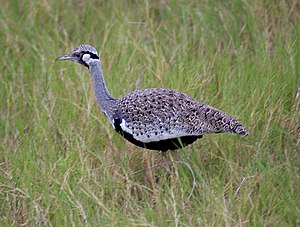Hard-leaved bustard
| Hard-leaved bustard | ||||||||||
|---|---|---|---|---|---|---|---|---|---|---|

Hard-leaved bustard (male) |
||||||||||
| Systematics | ||||||||||
|
||||||||||
| Scientific name | ||||||||||
| Lissotis hartlaubii | ||||||||||
| ( Heuglin , 1863) |
The hard- leaved bustard ( Lissotis hartlaubii ), also known as the black- eared bustard , is a species of bird in the bustard family . The art epithet honors the German ornithologist Gustav Hartlaub .
features
The male of the hard-leaved bustard reaches a size of 60 centimeters and a weight of 15 to 16 kilograms. The hard-leaved bustard is similar to the closely related black-bellied bustard ( Lissotis melanogaster ), but it is grayer and more clearly marked. The lower back, rump and tail are black. In the female, the head and back neck are cream to tan with darker brown markings. The belly is whitish and the tail is lighter than that of the male. The chicks are cream to tan in color with light and dark markings.
Occurrence
The distribution area of the hard-leaved bustard extends from eastern Sudan via Ethiopia to north-west and south Somalia, north-east Uganda, north-west and south Kenya to north Tanzania.
habitat
The hard-leaved bustard lives in open, high grasslands with isolated acacias at altitudes of up to 1,600 meters. In Kenya it occurs in drier habitats than the black-bellied bustard. In Ethiopia it prefers the acacia-covered short grass savannah and occurs there at altitudes of up to 2,000 meters.
Way of life
The hard deciduous bustard is usually true to location. However, observations of birds in the Serengeti have shown that they migrate through the savannah between January and February and between September and October. The main diet of the hard-leaved bustard consists of plants and invertebrates. In Ethiopia, breeding activity was observed in April. In East Africa, the breeding season is during the rainy seasons in January and June, when the grass is highest.
Systematics
The Hartlaubtrappe was described as Otis hartlaubii by Theodor von Heuglin in 1863 . Occasionally it is placed in the genus Eupodotis .
Individual evidence
literature
- Josep del Hoyo , Andrew Elliot, Jordi Sargatal : Handbook of the birds of the world. Volume 3: Hoatzin to Auks. Lynx Edicions, Barcelona 1996, ISBN 84-87334-20-2 .